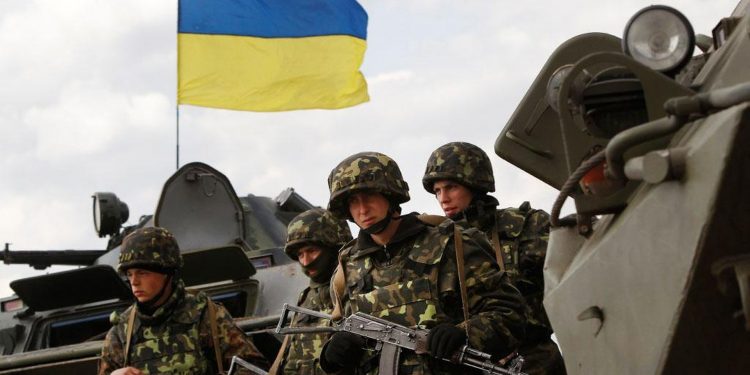Ukraine, sandwiched between Russia and the European Union, has since independence in 1991 been torn between its former Soviet master Moscow and the Western institutions it wants to join.
Here is an overview:
Independence and nuclear arsenal scrapped
In December 1991, Ukraine votes in favour of independence from the Soviet Union in a referendum.
Russian president Boris Yeltsin accepts the vote and Russia, Ukraine and Belarus set up a Commonwealth of Independent States (CIS).
But over the next five years, Ukraine seeks ways to escape Russia’s guardianship, which goes back three centuries.
Perceiving the CIS as an attempt to bring ex-Soviet republics under Moscow’s control, it takes a lukewarm approach to the structure and turns towards the West. It seeks ties with the US-led NATO military alliance — a no-go for Russia.
In the aftermath of the end of the Cold War, Ukraine, Russia, the UK and the US in December 1994 agree to respect the independence, sovereignty and borders of Ukraine. The agreement is in exchange for Ukraine abandoning the nuclear weapons it inherited from the Soviet Union.
Friendship treaty
In May 1997 Russia and Ukraine sign a friendship treaty without removing a main source of tension: Kyiv’s ties with NATO.
It settles a key disagreement by allowing Russia to retain ownership of the majority of ships in the Black Sea fleet based in Ukraine’s Crimea while requiring that Moscow pay Kyiv a modest rent to use the port of Sebastopol.
Moscow also remains Kyiv’s most important commercial partner, with Ukraine totally dependent on Russian oil and gas.
Ukraine draws a warning from the EU in 2003 when it signs an accord with Russia, Belarus and Kazakhstan on a Common Economic Space. Brussels says that it could hinder Ukraine’s rapprochement with the bloc and its membership to the World Trade Organization.
Pro-Westerner in power
Ukraine’s 2004 presidential election is marred by fraud and the victory of the pro-Russian Viktor Yanukovych provokes unprecedented protests in the peaceful Orange Revolution.
The uproar leads to the vote being cancelled and in December pro-Western opposition leader Viktor Yushchenko, who was the victim of a mysterious dioxin poisoning during the campaign, becomes president.
It marks the beginning of a new political era in Ukraine after 10 years under the thumb of Leonid Kuchma, who staggered between Europe and Moscow.
Yuschenko swiftly reiterates Ukraine’s wish to join the EU, despite reservations from the bloc, along with NATO.
In 2008 at a summit in Bucharest, NATO leaders agree that Ukraine has a future in the alliance, sparking Moscow’s ire.
Russia and Ukraine engage in several disputes, notably over gas in 2006 and 2009 which disrupt Europe’s energy supplies.
Pro-European uprising
Yanukovych is elected president in 2010, and in November 2013 he suspends talks on a trade pact with the EU in favor of closer ties with Russia.
It sparks weeks of massive protests by pro-European opposition groups demanding the pro-Russian president quits.
The uprising, center on Kyiv’s Independence Square, comes to a head in February 2014 when police fire on protesters.
Around 100 demonstrators and 20 police officers die during the three-month uprising.
Yanukovych flees to Russia and is impeached.
Annexation
Russia responds by sending special forces to take control of strategic sites on Ukraine’s Crimea peninsula.
In March 2014 Russian President Vladimir Putin signs a treaty absorbing Crimea into Russia.
The annexation provokes the worst diplomatic crisis between the West and Russia since the fall of the Soviet Union.
Then in April, a pro-Russian rebellion erupts in Ukraine’s industrial eastern areas.
Pro-Russian separatists in Donetsk and Lugansk declare their regions to be independent.
Ukraine and its Western allies accuse Russia of instigating the uprising and pouring in arms and troops to bolster the self-proclaimed republics.
The clashes become a full-blown conflict in May and the conflict has since left more than 14,000 people dead.
‘Military operation’
After massing tens of thousands of soldiers on Ukraine’s borders, Putin on February 21, 2022 recognizes the independence of Donetsk and Lugansk.
He also orders Russian troops into the regions, without giving the scope or timetable of the deployment.
A wave of Western condemnation and sanctions follows as diplomacy fails to deter Putin from seeking to redraw Ukraine’s borders.
The Russian leader announces a military operation on February 24, 2022 with explosions heard soon after in the capital Kyiv and other parts of the country.
“I have made the decision of a military operation,” Putin says in a surprise television announcement in Moscow.
He calls on Ukrainian soldiers to lay down their arms, claiming he wants a “demilitarization” of the former Soviet state but not its occupation.
US President Joe Biden says the Russian attack will cause a “catastrophic loss of life and human suffering” and says the world will “hold Russia accountable” for its actions.











